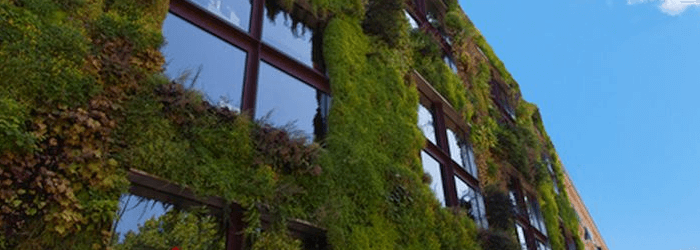
Green building is one of the most significant opportunities for sustainable growth at both national and global level. The built environment impact on all of us, on our economies, social dynamics and the natural environment.
The design of buildings, whether residential or commercial, has a place of importance in the quality of our comfort and health. The manufacturing, design, construction and operation of the buildings in which we live and work are responsible for the consumption of many of our natural resources. Conventional builds use a third of all raw materials, produce a third of all greenhouse emissions and create a third of all waste. Conventional buildings use almost forty percent of all energy and twelve percent of potable water. Green building practices reduce this energy consumption significantly and in some cases, totally.
Green building design has significant importance in schools, improving the students ability to learn as well as creating ecological awareness. In business, our workplaces influence employee productivity and health as well as business success. In hospitals, green designs have proven importance in patients' recovery periods, reducing their stay and the cost of their care.
Green buildings reduce the negative impact of building on the environment while at the same time showing respect for its social and economic value over its entire lifespan, from design and construction, through use and maintenance, up to renovation and demolition, largely through integrated operations from idea formation to final construction.
The importance of green building can be seen in three major areas: economic benefits, environmental benefits and social benefits:
Economic Benefits
Reduction in operating costs
Green buildings minimise energy consumption at every stage of a buildings life span from idea formation to final use. Green buildings can be new or renovated and are more comfortable, less expensive to maintain and better for the environment through the reduction of carbon dioxide and other carbons into the environment. At the same time, those using the building learn how to efficiently use energy resources elsewhere, to save both energy, money and the environment.
ICT technologies are also incorporated in green builds to improve communication through smart grids that distribute energy depending on the place and time of energy demand.
Adding and retaining financial value
Green buildings attract sales and rental premiums, help reduce capital expenditure and mitigate the risk of regulations requiring costly alterations to buildings. Energy and water efficient buildings also save money during the lifetime of the property for the tenants. Green buildings have a higher selling value and provide every company with a better market image.
Creation of jobs
The construction industry employs tens of millions of people worldwide, but there is a skills shortage. Green building has an importance in many ways, it offers a chance to be part of the solution to global challenges, to explore new and exciting technologies and to learn relevant, life-long skills, which are likely to attract talent and investment.
Increasing energy security and reducing fuel poverty
The cost of oil and gas imports cost countries hundreds of billions of pounds sterling each year. Higher energy efficiency will help reduce the amount of energy that needs to be imported and help those whose fuel bills represent a significant portion of income to save money.
Improving the provision of public services
The importance of a strong public sector in green building helps to lead the way for others to follow, whilst at the same time lowering the cost of running public buildings, increasing the efficiency of providing services and helping to create an environment that retains and supports the brightest ideas and innovations.
Create a market for green product and services
The building constructions sector is of major importance to a countries GDP and is forecast to continue growing. Green building allows for increased output with decreased impact. Greater resource efficiency, supported by government polices, are at the forefront of the global green buildings market.
Environmental Benefits
Reduce wastage of water
Effective management of water resources includes the efficient management of drinking and waste water for safe use indoors and a reduction of water use in building construction. Recycling grey-water and rainfall in a cohesive design, reduces waste and encourages recycling.
Conserve natural resources
Construction materials are a higher quality with a longer life-cycle than conventional materials. This reduces construction waste up right up to the point of conversion and demolition as materials are used, stored and recycled correctly.
Green designs can be flexible and dynamic spaces, so that change in use is possible without the need for demolition, rebuilding or renovation.
Green buildings are resistant to natural hazards, of particular importance to areas prone to floods, earthquakes or large fires. Green buildings keep people safe and last significantly longer than conventional builds. Green buildings can last up to one-hundred years in the commercial sector.
Improve air and water quality
Good ventilation maintains high indoor air quality created by the use of materials that do not contain volatile organic compounds, carbon-based compounds that easily evaporate at room temperature and are found in many materials.
Protect biodiversity and ecosystems
Green builds also have an importance in preserving nature in urban areas, ensuring the conservation of flora and fauna diversity as well as of soil quality. They also create green areas through the cleaning of contaminated soil to create rooftop or city gardens.
Social Benefits
Improve occupant health and comfort
The extensive use of natural light to illuminate rooms, plus views of the surrounding environment makes the space more comfortable and also reduces the need for artificial room lighting.
Improve occupant productivity
Acoustics and sound insulation are of great importance in providing an ambience, particularly in schools and hospitals, that is good for concentration, recovery as well as for enjoying work and spending time in one’s own home.
Improve quality of life
Green building solutions provide a pleasant indoor temperature regardless the outside temperature, with the possibility of users able to manage the micro-climate in a particular room or even at their own workstation.

